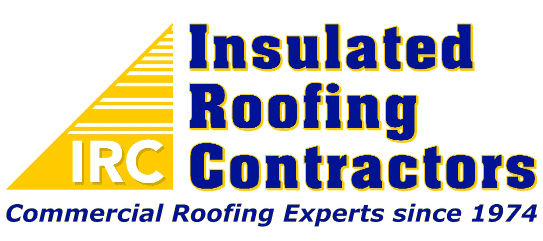According to the Bureau of Labor Statistics there were a total of 5,147 fatal work injuries and 194,300 nonfatal work injuries, in the construction industry, recorded in the United States in 2017. Here at Insulated Roofing Contractors (IRC) we take safety seriously, so serious that our employees spend nearly 5,200 man-hours in classrooms for safety training. That is approximately 40 hours of training per jobsite employee. We want our employees as trained as possible so no injuries or fatalities happen on the job. IRC strives to maintain a safe work environment and that’s why our recordable injuries on average are 2.5, while the national average for recordable injuries in the roofing industry are 6.0. Our men are regularly trained in electrical safety, fall protection and how important a safety harness is at heights 6 feet or more, eye and face protection, respiratory protection, any minor safety precautions, and we also teach them about the effects of unsafe work environments. We do this not to scare our men into doing the right thing, but to ensure that each night they get home safely to their families. In this series on Safety we are going to discuss, well you may have guessed it, SAFETY, and what we regularly train our men on to keep a safe work environment.
Electrical Safety
To maintain a safe work environment, every job site employee should know the hazards of working near electrical currents. The electrical exposures on a rooftop can range from over head power lines and building wiring to extensions cords and powered hand tools and welders. You should always treat any electrical lines as if they are energized. Before beginning a job survey the site for any overhead power lines, be sure to look in alleyways, tree lines and between buildings. If possible be sure to get any lines covered by the power company before beginning work. Employees must stay 10 feet away from any power lines. Be sure to check for power lines before raising ladders and do not erect scaffolds near power lines. Inspect all power tools and extension cords before use. If they seem to be an unsafe tool tag them out as “out of service”. Always be sure to look out for another roofer, warn them when an electric hazard is discovered.
Fall Protection
In 2017 alone, 381 people died from falls in the construction industry. Aside from vehicle collisions, jobsite falls are the number one way to die with roofing contractors and building finishers being the primary groups at risk. All falls are preventable, IF you have the proper fall protection in place. For a more safe work environment ensure there are no falls on the job, you must identify all potential tripping and fall hazards before work starts. Look for fall hazards such as unprotected floor openings/edges, shafts, skylights, stairwells, and roof openings/edges. Inspect fall protection equipment for defects before use. Select, wear, and use fall protection equipment appropriate for the task. Secure and stabilize all ladders before climbing them. Never stand on the top rung/step of a ladder. Use handrails when you go up or down stairs. Keep cords, welding leads and air hoses out of walkways or adjacent work areas.
Eye/Face Protection
In the construction industry, eye and face injuries are commonly caused by flying or falling objects, or sparks striking the eye or face. The severity of hazards may require different types of protection, from safety spectacles and goggles to face shields and should be selected in accordance with IOSH 1910.133, Eye and Face Protection. Safety glasses, as a minimum, are required where there is a potential of eyes being struck by projectile objects. Side shields are required if there is a hazard from flying objects from the side. Direct vented goggles are an acceptable substitute for safety glasses with side shields. Chemical splash goggles are required where protection is needed against chemical splashes or sprays. These may also be used where impact protection is required. Face shields are required where facial skin protection is needed, and can only be used in conjunction with eye protection. The face shield is not a substitute for the safety glasses or goggles. Selecting the appropriate protection for your eyes/face are essential for a more safe work environment and keeping you out of serious injury.
Respiratory Protection
When employees must work in environments with insufficient oxygen or where harmful dusts, fogs, smokes, mists, fumes, gases, vapors, or sprays are present, they need respirators. These health hazards may cause cancer, lung impairment, other diseases, or death. A respirator is a protective device that covers the nose and mouth or the entire face or head to guard the wearer against hazardous atmospheres. OSHA’s respirator standard requires employers to establish and maintain an effective respiratory protection program when employees must wear respirators to protect against workplace hazards. For every different work environment, there are different hazards that require different respirators, and employees are responsible for wearing the appropriate respirator and complying with the respiratory protection program. What’s on your face can save your lungs and life!
Misc. Safety Protection
We may sometimes forget, but to maintain a safe work environment we must protect ourselves from even the small equipment on the job. Blades and knives are something that are used daily in the construction industry and we forget just how dangerous they can be. When handling a knife make sure it is always sharp, watch for tearing instead of cutting. Pull the knife – never push it and always keep hands out of the path of travel. Wear cut resistant gloves when handling knives in case of an accident. Always close the blade when not in use.
Another piece of equipment we hand is the power washer. This might not seem dangerous, but can lead to serious injury if used as a toy. Never point the gun valve at yourself or another person. Always wear proper skin, foot and face protection. Check all hose connections to ensure they are in the locked position before starting and always relieve the pressure in the system before uncoupling the hoses. Remember to handle ALL tools and equipment properly, failure to do so could cost you or a team member their life.
Effects of Unsafe Work Environments
We’ve talked a lot about how to maintain a safe work environment. Some common unsafe acts are running, horseplay, not following procedures, by-passing safety devices, not using PPE, unauthorized equipment operations and using drugs and alcohol. These are just a few acts that could lead too serious injury or a potential fatality if the situation gets to out of hand. Unsafe work environments are anything dealing with ergonomic hazards, environmental hazards, inadequate housekeeping, blocked walkways, improper or damaged PPE and inadequate machine guarding. By identifying hazards at your workplace, you will be better prepared to control or eliminate them and prevent accidents, injuries, property damage, and downtime. Your work environment is only as safe as you and your coworkers make it. Be sure to protect everyone at all costs!
